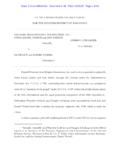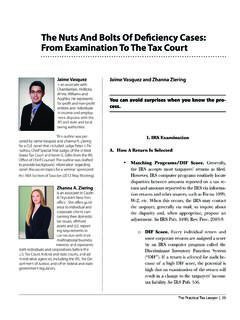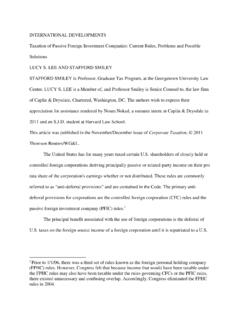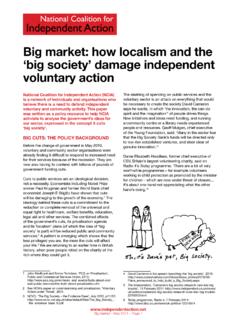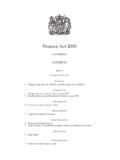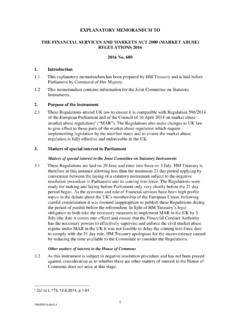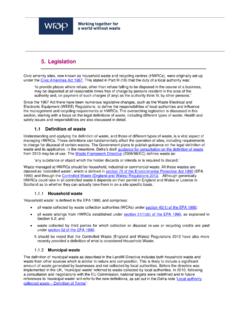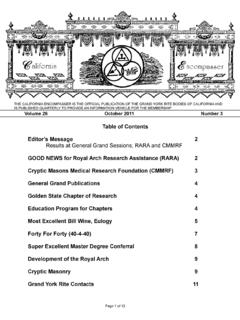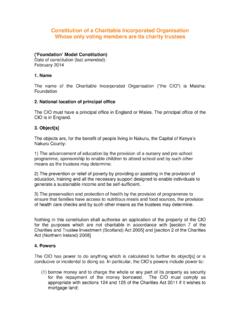Transcription of Procedural Considerations in Addressing Chapter 42 Excise ...
1 1 | P a g e Procedural Considerations in Addressing Chapter 42 Excise Tax Consequences September 14, 2012 Michael W. Durham Member, Caplin & Drysdale I. Chapter 42 Excise Taxes Since 1969, private foundations have had to comply with the various requirements of Chapter 42 of the Internal Revenue Code, or face its quite draconian penalties. More recently, Congress has gradually added similar provisions applicable to disfavored activities by public charities, all charities, or (in the case of section 4958) section 501(c)(3) and 501(c)(4) organizations. Most of these provisions also include taxes on management for knowing violations, as well as second-tier taxes in case of failure to correct the transaction within the applicable correction period.
2 The chart below summarizes these provisions: Code Section Topic Tax Frequency Manager s Tax Second-Tier Tax Applies to 4941 Self-dealing No abatement 10% of amount involved (on the self-dealer) Each year until correction; pyramiding for loans, leases, etc. 1st Tier: 5% 2nd Tier: 50% Each up to $20K 200% Disqualified persons of PFs, and of some charitable or split-interest trusts. 4942 5% payout 30% of undistributed income Each year income remains undistributed. None 100% Private Foundations 4943 Excess business holdings 10% of value of excess holdings Each year in which the excess holdings continue None 200% PFs, some 509(a)(3)s, DAFs 2 | P a g e Code Section Topic Tax Frequency Manager s Tax Second-Tier Tax Applies to 4944 Jeopardizing investments 10% per year of amount invested Each year until amount removed from jeopardy 1st Tier: 10%, up to $10K 2nd Tier: 5%, up to $20K per investment 25% Private Foundations 4945 Taxable expenditures 20% of expenditure Once (but see Mott case1) 1st Tier: 5%, up to $10K 2nd Tier: 50%, up to $20K per expenditure 100% Private Foundations 4955 Political Expenditures 10% of expenditure Once 1st Tier.
3 5%, up to $5K 2nd Tier: 50%, up to $10K per expenditure 10% 501(c)(3) organizations 4958 Excess benefit transactions 25% of excess benefit on the DP (or 25%vof whole amount for some DAF/SO grants, loans, compensation, or similar payments) Once 1st Tier: 10%, up to $20K 200% (on DP) Disqualified persons of 501(c)(3)s, 501(c)(4)s 4965 Prohibited tax shelters No abatement Greater of 100% of net income from participation or 75% of Once $20,000 None Many tax-exempt entities or entities eligible to receive tax- 1 In Charles Stewart Mott Foundation v. United States, 938 58 (6th Cir. 1991), the court upheld two section 4945 taxes on the same program related investment, because the organization failed to attach the required reports to its Form 990-PF in two consecutive years.
4 Thus, appears that at least sometimes a single grant can result in multiple violations of section 4945. 3 | P a g e Code Section Topic Tax Frequency Manager s Tax Second-Tier Tax Applies to proceeds (if it knows or has reason to); otherwise, the tax on that amount deductible contributions 4966 DAF taxable distributions 20% of distribution Once 5%, up to $10K None Sponsoring organizations 4967 Prohibited DAF benefits to donors/advisors 125% of benefit Once 10%, up to $10K None Donors/advisors of DAFs and related parties II. Assessing Chapter 42 Exposure and Options Short of Disclosing to the IRS When a Chapter 42 violation comes to the attention of an organization, the first step is to try to determine exactly what occurred, as the details of the act or failure to act can often make a profound difference in the amount and type of tax assessed.
5 At the same time, the lawyer needs to be prepared to spend a fair amount of time helping disqualified persons and foundation managers adjust to the reality that even innocently intended conduct may result in serious exposure. What? Given the hefty taxes and potential audit exposure associated with reporting a Chapter 42 violation, an organization is well-served to thoroughly examine the facts and applicable authorities to make absolutely sure that a violation has occurred. While in some cases the question of whether a violation has occurred is a factual one, in many cases the precise scope of the Excise tax is unclear, or depends on state law to determine whether the predicate act for the Excise tax has occurred.
6 For instance, in the case of section 4967 of the Code, there is not yet clear guidance on whether it would be an impermissible benefit for a donor advised fund to satisfy the enforceable pledge of a donor; even assuming that satisfying an enforceable pledge would be subject to tax under section 4967, difficult questions under state law can arise as to whether such a pledge is in fact enforceable. When? Sometimes as crucial as whether a Chapter 42 violation has taken place is when it took place. Most of the Excise taxes applicable to private foundations impose additional tax for each year or part of a year that the transaction continues uncorrected. Especially for investments made on fixed closing dates (for instance, investment or disinvestment in a fund that allows such changes only at the end of a calendar year or quarter), it is not uncommon for payment to be made in one taxable year and delivery of the investment in another taxable year.
7 Total Excise tax exposure could potentially double depending on when in that process the sale or investment in question occurred for Chapter 42 purposes. Also, determining in which taxable year a transaction occurred can affect when the statute of limitations will run. Determining the taxable year is crucial because it often dictates the 4 | P a g e date by which any necessary correction must occur in order to avoid additional Excise taxes which can sometimes be soon in the future if the problem was discovered in the preparation of the previous year s extended return. Who? For these purposes, it is important to distinguish which taxes apply and which parties are subject to them, as each party may have a different taxable year.
8 Thus, for instance, self-dealing penalties are applied based on the tax year of the disqualified person subject to the tax, but the same action may also trigger liability for making a taxable expenditure for the private In many cases, it is clear who the party involved in a transaction is. However, the section 4941 regulations do also treat others participating in a transaction, including those who direct a transaction, as participants jointly and severally liable for the In some cases this provides needed flexibility, because the party most obviously participating in the transaction is not the most appropriate party to pay the tax (for instance, because it lacks the financial resources to do so, or it is a 35%-owned entity with outside shareholders who would be unfairly harmed if they had to share the tax burden with the ultimate disqualified persons).
9 Another important Who? question is who had sufficient knowledge that they might be subject to manager s tax. On audit, it is perfectly possible for the IRS to conduct interviews of board members or others to determine how much knowledge they have. A. Pyramiding and Problems with Doing Nothing 2 Rev. Rul. 75-391, 1975-2 446. 3 Treas. Reg. (a)-1(a)(3). 0 100 200 300 400 500 600 700 800 900 2007 2008 2009 2010 2011 2012 2013 2014 2015 Cumulative Excise Tax Total First-Tier Tax for a 2007 Loan/Gift of $1,000 (assumes 6-year statute of limitations and no correction) PF $1,000 grant PF $1,000 loan (10% market rate) SO $1,000 grant/loan to substantial contributor 5 | P a g e Normally, a given transaction generates a single act of self-dealing.
10 However, where the transaction is the lending of money, lease of property, or other use of foundation property, it is treated as giving rise to an act of self-dealing on the day the transaction occurs plus an additional act on the first day of each subsequent year (or part year) until the transaction is corrected or the second tier tax is Since each act of self-dealing attracts the 10 percent tax for each year until correction, there is a pyramiding effect. Thus, if the use of property commences in year 1 and is terminated in year 3, the use value for year 1 is subject to a total of 30% in tax for years 1, 2, and 3; the use value for year 2 is taxed a total of 20% for years 2 and 3; and the use value for year 3 is taxed at 10% for that year Once the statute of limitations for a particular act of self-dealing ends, the Service cannot assert any 4941 tax for that transaction, even for subsequent uncorrected years.
